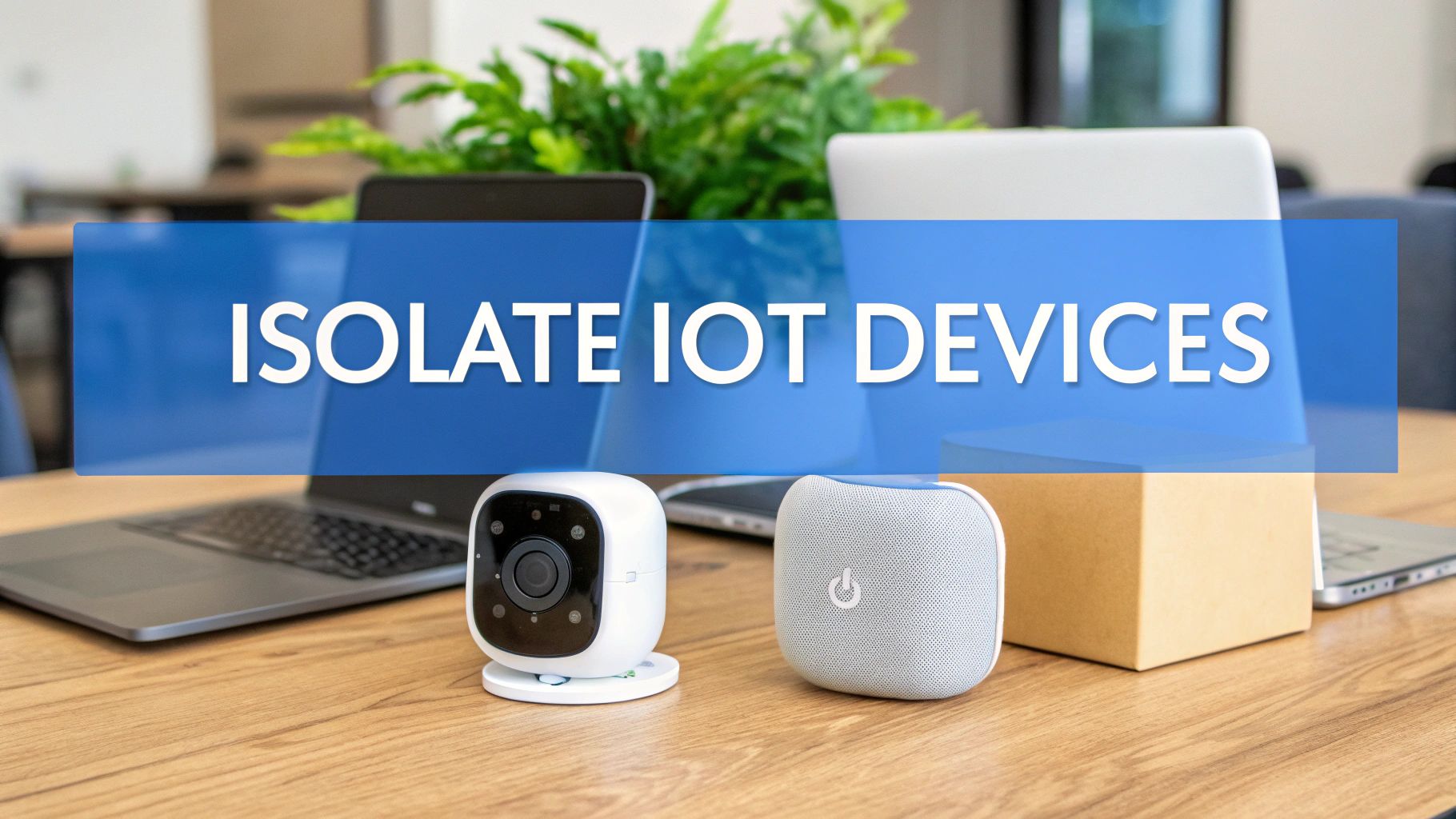As a Managed Service Provider (MSP) or vCISO, you know that a single breach can put a client's entire network at risk. Strong network segmentation isn't just a technical control; it's a core business strategy that contains threats and protects sensitive data. Think of it like putting up walls in a big open building. If a problem starts in one room, it stays in that room instead of spreading everywhere. This is crucial for meeting compliance standards like SOC 2, HIPAA, and PCI DSS.
The challenge is that building these walls is only half the battle; proving they work is what really matters. Many partners face inflated prices and long waits for the validation they need. Our goal is to provide a clear roadmap to the most effective network segmentation best practices, backed by affordable, manual pentesting to verify your controls are working. We are a channel-only partner, meaning we support your business without ever competing for your clients.
This guide offers actionable strategies you can implement immediately. We will cover everything from foundational VLANs and DMZs to advanced microsegmentation and Zero Trust principles. This solidifies your role as a trusted advisor and shows real value to your clients. Let's explore the practices that will strengthen your security offerings.
Adopt Zero Trust Architecture for Security
Zero Trust is a modern security model built on a simple rule: never trust, always verify. It assumes no one is safe, even if they're already inside the network. This is different from the old "castle-and-moat" idea where everything inside the wall was trusted. Instead, every request to access something is checked, authorized, and encrypted before it's allowed.

This model treats every part of the network as potentially hostile, which shrinks the attack surface. If an attacker gets into one area, they can't move to others without being checked again. By enforcing strict identity verification, Zero Trust ensures a breach in one area doesn't compromise the whole network.
Implementing Zero Trust requires a step-by-step approach. Start with a small pilot program to work out the kinks. As you expand, focus on strong identity management, use multi-factor authentication (MFA) everywhere, and create tiny security zones with micro-segmentation. This strategy is fundamental to this process. Also, be sure to log all traffic to spot threats in real-time.
Implement VLANs for Foundational Network Segmentation
VLAN segmentation is a basic technique that creates separate logical networks on a single physical setup. It's like using room dividers to create different sections in a large hall. You can group devices and users together no matter where they are physically located, which isolates traffic and keeps things organized. This method tags data packets with a VLAN ID, so switches only send traffic where it belongs.
As an MSP or vCISO, focus on deploying a well-documented VLAN architecture. Use the standard 802.1Q tagging, secure the trunk ports that carry traffic between VLANs, and use firewalls to control inter-VLAN routing. Don't forget to keep your documentation updated and regularly review your VLANs to remove any that are no longer needed.
Use Microsegmentation for Granular Security Zones
Microsegmentation takes network segmentation to a very detailed level. It involves dividing the network into tiny, isolated security zones, sometimes down to a single application. This approach operates on the same "never trust, always verify" principle as Zero Trust, making it almost impossible for an attacker to move around if they get in.
This method creates a secure perimeter around every single application or workload. If one segment is breached, the damage is contained to that single spot. By creating these workload-level perimeters, microsegmentation drastically shrinks the attack surface and is a cornerstone of modern network segmentation best practices.
For MSPs and vCISOs, implementing this requires a deep understanding of network traffic. Start by identifying your most critical assets and mapping out how they communicate. Then, create "allow by exception" policies, where all traffic is blocked unless specifically permitted.
Create a DMZ for External Services
A DMZ, or Demilitarized Zone, is a buffer network between your secure internal network and the untrusted internet. It’s a safe place to put public-facing services like web or email servers. This setup allows external users to access what they need without giving them a direct path into your core network.

This approach is a proven method for protecting critical assets. For example, an e-commerce company places its public web server in the DMZ, while the database with customer data stays on the internal network. By creating a secure buffer zone, a DMZ ensures that a compromise of an external server doesn't lead to a breach of the entire internal network.
Implementing a robust DMZ requires careful planning and precise firewall configuration. The goal is to permit only essential traffic. Use a two-firewall architecture for maximum security, enforce strict "deny-all" rules by default, and harden all servers in the DMZ. Continuously monitor DMZ traffic to watch for any suspicious activity.
Enforce Network Access Control for Endpoints
Network Access Control (NAC) is a security solution that acts like a digital gatekeeper. It checks every device trying to connect to the network to make sure it meets your security standards. This prevents devices with outdated antivirus or missing security patches from joining the network and introducing threats.
By automating this validation, NAC ensures only trusted devices can communicate within a given segment. This is crucial in places with lots of different devices, like a hospital securing medical equipment. NAC enforces security hygiene at the point of entry, ensuring every device meets compliance standards.
To implement NAC effectively, start by defining clear compliance policies. Roll it out in phases, beginning in "monitor-only" mode to see what devices are non-compliant. Integrate it with your identity systems and set up automated remediation to guide users to fix their devices, which saves your help desk a lot of time.
Secure Applications with Application-Level Segmentation
Application-level segmentation goes beyond network addresses and ports to control access based on application identity. This modern approach protects applications and their data with dedicated security policies. It ensures only authorized services and users can interact with specific resources, creating a secure perimeter around each application.
This method is crucial for complex environments where applications are the new perimeter. It prevents unauthorized communication between services, limiting an attacker's ability to move from a compromised application to other systems. By focusing security controls on application identity and data flows, this method provides granular protection that is essential for modern network segmentation best practices.
To implement this, you need to meticulously map all application communication patterns first. Use API gateways to centralize and enforce access control for all application-to-application communication. For containerized environments like Kubernetes, a service mesh can help manage and secure traffic automatically. And always monitor application behavior for any anomalies.
Use Physical Segmentation for Critical Assets
Physical network segmentation is the most secure method of isolation. It involves using completely separate, dedicated hardware to create "air-gapped" networks that are not connected. This ensures that a compromise in one environment cannot logically cross over to another, providing the highest level of assurance against lateral movement.
This method goes beyond logical controls like VLANs and enforces separation at the hardware level. Military and government agencies use physically separate networks to handle classified information. By creating a true "air gap," physical segmentation offers an unparalleled level of security, making it the ultimate solution for protecting the most sensitive and critical assets.
While highly effective, this method is also the most resource-intensive. Reserve it for systems where a breach would be catastrophic, like industrial control systems or top-secret data networks. You'll need to implement strict physical access controls, use dedicated management networks, and maintain meticulous documentation of every physical connection.
Deploy a Software-Defined Perimeter (SDP)
A Software-Defined Perimeter (SDP) takes the Zero Trust concept and creates a dynamic, on-demand network for each user. Instead of relying on static firewalls, an SDP makes infrastructure invisible to unauthorized users. This "authenticate first, then connect" model ensures that devices and users are verified *before* gaining any network access.
This approach is a direct replacement for the old 'castle-and-moat' model. An SDP builds a secure, encrypted tunnel between a user's device and the specific application they need, preventing lateral movement by design. SDP makes the network 'dark' to attackers by granting access on a session-by-session basis after strict authentication.
Implementing an SDP requires a shift to identity-centric security. It’s highly effective for protecting remote teams and distributed assets. Make sure you have robust identity management in place first. Deploy your SDP gateways for high availability and integrate them with threat intelligence feeds for adaptive access decisions.
Isolate Guest and IoT Device Networks
Isolating guest and Internet of Things (IoT) devices is a fundamental practice. This strategy involves creating dedicated, separate networks for non-corporate devices like guest smartphones, smart TVs, and security cameras. By doing so, you prevent these often less-secure devices from accessing sensitive corporate data.

This approach treats guest and IoT networks as untrusted zones with more restrictive security policies. This containment is critical because IoT devices are frequently targeted by attackers. By creating a firewalled "digital sandbox" for these devices, you significantly limit the potential damage from a compromise. A comprehensive approach to identifying these vulnerabilities is crucial.
To implement this, create separate VLANs and SSIDs for guest and IoT traffic. Apply strict firewall rules to block any traffic from these segments to the internal corporate network. Also, control outbound traffic to prevent compromised devices from being used in attacks. Using a NAC solution can also help ensure only approved devices can connect.
Segment Development, Test, and Production Environments
Environment-based segmentation is a critical practice that isolates development (Dev), testing (Test), and production (Prod) networks. This ensures that unstable code from development or testing can't accidentally impact your live, customer-facing systems. By creating distinct boundaries, you protect production data and maintain system stability.
This approach is foundational for modern DevOps. Each environment has its own security policies and access controls. For instance, a SaaS company might use separate cloud VPCs for each environment. Separating these environments is a fundamental control that drastically reduces the risk of operational disruptions and data breaches.
To implement this effectively, use automated CI/CD pipelines to manage the promotion of code between environments. Define your infrastructure using tools like Terraform to ensure consistency. Never use live production data in Dev or Test environments; use anonymized or synthetic data instead. And always enforce the principle of least privilege, limiting developer access to production.
Verify Your Segmentation with a Trusted Partner
Implementing network segmentation is a huge step, but you need to know if it actually works. You’ve planned your strategy and set up your defenses. The critical question now is: did it work? The only way to truly validate your segmentation controls is to simulate a real-world attack with a thorough penetration test. It provides real proof that your security measures are holding strong. A comprehensive risk assessment is incomplete without this crucial step.
For MSPs, vCISOs, and GRC firms, proving your security measures are effective is a powerful way to stand out. Your clients depend on you to protect their assets and maintain compliance with standards like SOC 2, HIPAA, PCI DSS, and ISO 27001. Offering validation services shows you are committed to delivering real security outcomes, not just implementing technology.
The problem is finding a reliable partner for this validation. The industry has a problem with long lead times, inflated prices, and automated scans that aren't true penetration tests. This is the problem we solve. As a channel-only partner, we never compete with you. Our mission is to empower you to deliver high-quality, manual pentesting services to your clients, completely under your brand.



.avif)
.png)